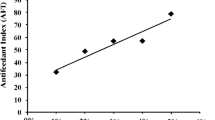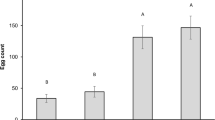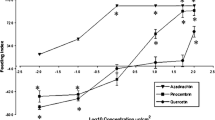Abstract
More than twice the number of mated female Hessian flies,Mayetiola destructor (Say) entered a zone within 1 cm of a paper strip treated with one plant equivalent (PE) of a chloroform extract of wheat foliar waxes compared to a strip treated with solvent only; females also stayed six times longer and laid 10 times more eggs on the strip treated with the wheat extract. Column chromatographic fractionation of the wheat extract and application of these fractions onto filter paper strips showed four fractions elicited significant numbers of eggs to be laid. Single, binary, and tertiary combinations of three of these fractions (two of the four fractions apparently contained similar compounds) were tested. The greatest numbers of eggs were laid on strips treated with the tertiary combination or the binary combination conaining the two most active fractions (3 and 6); three times the number of eggs were laid on strips treated with this binary combination than the sum of eggs laid on strips treated with these two fractions separately. A comparison of grasses and their extracts showed female Hessian flies laid greater numbers of eggs on wheat or rye than on barley or oat. Fractionated barley and oat extracts were tested for activity as for wheat, and a similar pattern was observed, i.e., the greatest numbers of eggs were laid on fractions 3 and 6. Dose-response tests, using these two fractions of wheat, barley, or oat showed the same threshold of activity for fraction 3 for all three extracts, i.e., 2 PE. In contrast, fraction 6 of wheat was active at the lowest dosage tested, 0.25 PE, while the same fraction of either barley or oat was not active until tested at a dosage of 2 PE. It appears that (at least) two chemicals in the foliar waxes of these grasses influence ovipositional behavior of female Hessian flies. Furthermore, given the similar foliar chemistry of these grasses and the strong synergistic interaction between fractions 3 and 6 shown for wheat extract, it is likely that the ovipositional preferences exhibited by female Hessian flies towards these grasses may be explained by quantitative differences in the amount(s) of the active chemical(s) in their respective fraction 6 (most polar fraction tested).
Similar content being viewed by others
References
Blanchi, G., andFigini, M.L. 1986. Epicuticular waxes of glaucous and nonglaucous wheat lines.J. Agric. Food Chem. 34:429–433.
Buttery, R.G., Xu, C.-J., andLing, L.C. 1985. Volatile components of wheat leaves (and stems): Possible insect attractants.J. Agric. Food Chem. 33:115–117.
Gallun, R.L., Starks, K.J., andGuthrie, W.D. 1975. Plant resistance to insects attacking cereals.Annu. Rev. Entomol. 20:337–357.
Harris, M.O., andRose, S. 1989. Temporal changes in the egglaying behaviour of the Hessian fly.Entomol. Exp. Appl. 53:17–29.
Harris, M.O. andRose, S. 1990. Chemical, color, and tactile cues influencing oviposition behavior of the Hessian fly (Diptera: Cecidomyiidae).Environ. Entomol. 19:303–308.
Hatchett, J.H. 1986. Biology and genetics of the Hessian fly and resistance in wheats.In Proceedings, International Wheat Conference, Rabat, Morocco.
Jones, E.T. 1938. Infestation of grasses of the genusAegilops by the Hessian fly.J. Econ. Entomol. 32:505–510.
Kate, M. 1972. Techniques of Lipidology: Isolation, Analysis and Identification. North Holland/ American Elsevier, New York, 610 pp.
McColloch, J.W. 1923. The Hessian fly in Kansas. Agricultural Experiment Station Technical Bulletin 11, Manhattan, Kansas.
Morrill, W.L. 1982. Hessian fly: Host selection and behavior during oviposition, winter biology, and parasitoids.J. Ga. Entomol. Soc. 17:156–167.
Morrill, W.L., andNelson, L.R. 1976. Hessian fly control with carbofuran.J. Econ. Entomol. 69:123–124.
Pike, K.S., andAntonelli, A.L. 1981. Hessian fly in Washington. Washington State University Research Center No. XB0909. Washington State University, Pullman.
Städler, E., andBuser, H.R. 1984. Defense chemicals in leaf surface wax synergistically stimulate oviposition by a phytophagous insect.Experientia 40:1157–1159.
Stokes, B.M. 1957. Observations and experiments on the Hessian fly (Mayetiola destructor Say).Ann. Appl. Biol. 45:122–132.
Tulloch, A.P., andHoffman, L.L. 1971. Leaf wax of durum wheat.Phytochemistry 10:871–876.
Tulloch, A.P., andHoffman, L.L. 1973. Leaf wax ofTriticum aestivum.Phytochem. 12:2217–2223.
Tulloch, A.P., Baum, B.R., andHoffman, L.L. 1980. A survey of epicuticular waxes among genera of Triticeae. 2. Chemistry.Can. J. Bot. 58:2602–2615.
Author information
Authors and Affiliations
Rights and permissions
About this article
Cite this article
Foster, S.P., Harris, M.O. Foliar chemicals of wheat and related grasses influencing oviposition by Hessian fly,Mayetiola destructor (Say) (Diptera: Cecidomyiidae). J Chem Ecol 18, 1965–1980 (1992). https://doi.org/10.1007/BF00981920
Received:
Accepted:
Issue Date:
DOI: https://doi.org/10.1007/BF00981920




